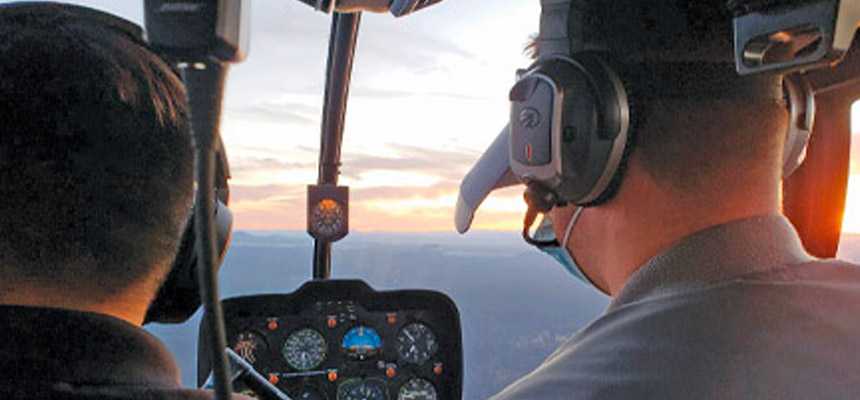(Carl Manning in a helicopter cockpit with an instructor | Photo courtesy of Carl Manning)
For students dreaming of soaring through the heavenlies while piloting an aircraft, the Central Oregon Community College (COCC) Aviation Program offers an excellent way to achieve that goal.
“We have a degree-seeking program that in the end yields a professional pilot armed with a two-year aeronautical science degree,” says Karl Baldessari, director of the program. “The number of certifications and flight hours vary, but if a student comes to us with the goal of becoming a commercial helicopter or airplane pilot, they can walk away with a two-year degree, a minimum of five FAA certifications and either 200 or 300 flight hours depending upon whether they are a helicopter or airplane pilot.”
Upon graduation, the aviation students can also become flight instructors for the COCC program. “We don’t guarantee employment, but we encourage students to apply to be flight instructors for us,” says Baldessari. “Most of our instructors are graduates: Approximately 80 percent of them are from our pool of graduates.”
Carl Manning, who is nearing completion of COCC’s helicopter degree, is one such student instructor. Manning has just one lab left to complete before graduating with his associate degree and has been hired by the college as a flight instructor for the helicopter program. “They are really thorough at the college, and the flight school they partner with (Leading Edge Flight Academy) is really good,” he says. “I feel like I have gotten through fairly quickly for someone with my experience.” His previous experience with helicopters, he says, involves being transported in them — and sometimes jumping out of them — while serving as an infantryman for the U.S. Army. “I finished my active-duty service obligation in 2018 and didn’t really think I was cut out for going to college, so I had to think about what I was going to use my education benefits for,” he explains. “Then I found this program and thought it would be a good path for using my benefits.”
Manning, who is married and has a one-year-old baby with another one on the way, says learning to fly did not come without its challenges. He had to work around COVID closures, and the sleep deprivation that comes from having a newborn. “The school shut down for a couple of months in 2020, and that was when I was a student pilot working toward becoming a private pilot. The time away from flying was hard.” He adds, “My wife and I also had a newborn during an intensive time in my flight training. The lack of sleep was tough, and the rating I was working toward was fairly demanding.”
Despite the hurdles, Manning says he has lots of fun flying around and has developed a heightened sense of confidence as a pilot. “There is a big difference between being a student pilot versus where I am now,” he says. “The instructors at the college are very knowledgeable, and the program is effective at developing pilots.”
COCC’s Aviation Program has a current enrollment of about 240 students, and Baldessari says the pandemic did not hinder it at all. “Unlike a lot of colleges across the country, and not unlike COCC as a whole, our program has not seen a decline. It leveled off early on, but by fall of 2020, we started seeing incremental increases every single quarter,” he says. The department had seen a growth trend before the pandemic due to a shortage of pilots, he says, and that trend has continued. “There was an identified shortage of pilots within the aviation industry that began several years prior to the pandemic. If anything, the pandemic made the shortage worse, because airlines and others who were forced to limit operations during the pandemic were not really training new pilots,” he explains. “There was a gap in experience, and some flight schools closed down. Now, the aviation industry is learning how to work around the pandemic, and as a result, the experience gap is rearing its ugly head. Nothing was being done to address the shortage before, and now airliners are back in the air, planes are full and there’s no more social distancing. The demand has come back very quickly.” He adds, “I think this is why we have seen a consistent increase in enrollment. We expect this to continue, and we think we’ll see the industry continue to offer incentives for pilots and for students who want to become pilots.”
Helicopter students have also reaped the benefits of the pilot shortage, Baldessari says. “There is such a demand for pilots that the airlines have created programs to transition helicopter pilots into commuter airline cockpits for the smaller airlines. So now, not only is there a really bright future for airplane pilots, but the draw is also there for helicopter pilots.” He adds, “Thanks to the airlines, they are making it a really good time for anyone who wants to be any kind of pilot.”
Horizon Air partners with COCC to offer a pilot development program that creates an industry opportunity for those who have completed private pilot training at the college. Those accepted into the program complete training and build experience as a COCC flight instructor, which then leads to a position as a first officer with Horizon Air. The program offers a guaranteed two-year contract with Horizon and a $12,500 training stipend.
“The Horizon program has been expanded,” says Baldessari. “COCC made a concerted effort throughout the pandemic to maintain our relationship with Horizon Airlines. Twice a year, they visit the campus to recruit pilots. It’s a competitive program; as soon as a student has completed the first phase, which is the private pilot training, they have qualified to compete for a position in the Horizon program.” He continues, “The students complete their resume and application, and when Horizon comes to campus, they have already vetted the list of students and decided ahead of time who they want to interview.” When students are accepted, they go back to school and continue their degree and certifications, and then work for COCC as instructors upon graduation, he says.
About two-thirds of the way through the Horizon program, if the student still wants to work for Horizon and Horizon still wants the student to work for them, the student will sign a contract committing to two years of service and to completing their flight training. They are guaranteed a job two years before actually being qualified for the job. “It’s like a mentorship program; there will be people grooming those candidates,” says Baldessari. “They literally go from being a flight instructor for us one day to being a Horizon pilot the next. So within 15-18 months of graduation, they could be flying for the airlines.”
Another factor in the growth of COCC’s Aviation Program, Baldessari says, is the substantial increase in salaries for pilots. “What has continued to benefit our students and graduates is that not only have the opportunities in terms of employment gotten better over the years, but also the salaries associated with those jobs. Historically, many people saw these aviation programs at two-year colleges or aeronautical universities as very expensive degrees. Now, however, because of demand, we don’t see too many people balk at the cost of the degrees anymore.”
COCC offers four Aviation degree options — airplane, helicopter, unmanned aerial systems (drones) and aviation technology and management. Each degree is built around Federal Aviation Administration (FAA) and industry standards. Flight simulators and a full range of aircraft at the Bend Airport help students progress quickly. “Our program can be less expensive than attendance at a four-year university, and the students have a viable skill upon graduation,” says Baldessari. “When you look at a two-year option, you can get into the industry sooner than your four-year peers, and often those students don’t walk away with a viable marketable skill.”
Baldessari says the drone industry is also growing, so COCC’s student population in this degree program has increased alongside its counterparts. “The FAA is beginning to catch up and broaden its rules and regulations to allow a progressively increasing usage of drones,” he says. “Amazon has its own drone division. The FAA hasn’t approved widespread usage yet, but if big companies like Amazon and Walmart are using them, we assume lobbyists are knocking on doors to get this done.” Here in Central Oregon, he says there are two viable drone companies: Volansi, which is newer, and UAV Factory, which is bigger and has been around longer. “We are hoping to open up relationships with these companies to develop programs for our drone students.”
An airplane degree at COCC will cost about $85,000, he says, while the helicopter degree costs about $110,000 and the drone degree is about $15,000. “But the salaries are all increasing, and this offers encouragement to students, because now it’s a viable degree path.” He continues, “The cost of the education has become more palatable than in the past. Students and parents are now looking at programs like this more.” He adds, “This whole concept was difficult to sell or explain five to six years ago, but as the pilot shortage has become more and more of an issue, we find that people have accepted this a little easier.” Diversity among pilots has also increased in recent years, he says. “This is viable for everybody now; there has been a big effort on our part to create diversity. I am 62 years old, have been a pilot for many years, and I have never seen anything like this before.”



